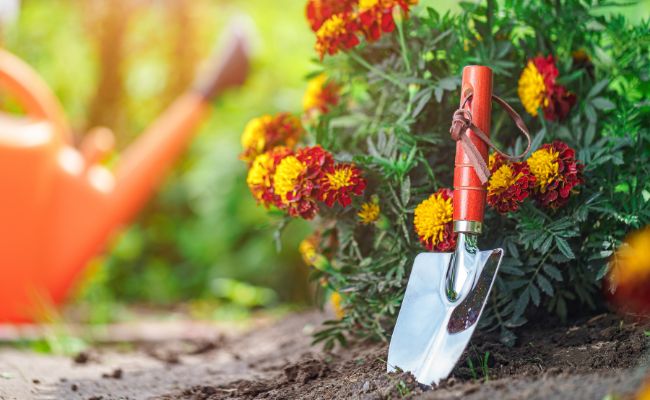The best way to Defend Crops From Frost This Winter
With winter comes frost and freezing temperatures. Whereas many crops are winter-hardy, others could also be damaged by as little as one night time time of frost.
Uncover methods to defend crops from frost with straightforward strategies like timed irrigation or further eternal choices like greenhouses and heat banks.
How Frost Damages Crops
When temperatures attain freezing or underneath, ice crystals develop inside plant cells. The ice may rupture the plant’s cells, damaging elements of the plant or killing it. Frost can also hurt plant roots.
Frost and freeze events are utterly totally different. A frost is often when the temperature reaches 36°F, and the crops may be capable to recuperate. A freeze is 32°F, and a troublesome freeze is 28°F or lower. Crops couldn’t have the flexibility to recuperate from a freeze or exhausting freeze.
Want further gardening strategies? Be part of our free gardening e-newsletter for our best-growing strategies, troubleshooting hacks, and further!
Indicators of Frost Harm
Indicators of frost hurt on crops embrace:
- Droopy or limp leaves
- Browned or blackened leaves
- Diminished progress
- Lifeless plant matter
- Whole low cost in plant vigor
Types of Crops to Defend From Frost
Prioritize primarily probably the most at-risk crops sooner than frost develops:
- Most annuals: Petunias, zinnias, nasturtiums, and plenty of others
- Some greens: Tomatoes, peppers, spinach, eggplant, and others
- Some tropicals: Dahlias, hibiscus, angel’s trumpets, fruit timber, and further
Relocation
Overwinter delicate crops by shifting them indoors. Crops already in containers could also be moved intact to a sunroom or totally different applicable place inside the home. It is usually attainable to maneuver plant specimens:
- Trim the plant: Cut back the plant by one-third.
- Transplant the plant: Switch the plant and its root ball to a container filled with potting soil.
- Acclimate the plant: Alternate the plant in and out of the house, one week at a time.
- Check for pests: Sooner than shifting, take a look at the plant for mites and bugs, and take away them.
- Switch the plant: Switch the plant indoors for the winter sooner than freezing local weather develops.
Mulching
Defend plant roots by together with a thick layer of mulch throughout the bottom. Like a blanket, mulch insulates the soil and retains temperatures regular.
The perfect time to make use of mulch to the crops is in late fall. For frost-proofing, you need to use each pure or inorganic mulch:
- Pure mulch: Pure mulch, produced from dwelling points, accommodates grass clippings, leaves, and wood, amongst others. Pure mulch every insulates and gives nutritional vitamins to the soil.
- Inorganic mulch: Inorganic mulch is produced from rubber chips, plastic, rocks, and totally different synthetic or mineral elements. Inorganic mulch will insulate the roots in direction of frost nevertheless just isn’t going so as to add nutritional vitamins.
Chilly Frames
Creating a cold physique is a popular choice to defend crops from frost hurt.
A cold physique is a low development constructed over and throughout the plant nevertheless not touching the plant. A sloped, clear lid lets photo voltaic in, for warmth, and the raised sides help defend the crops from the chilly. You probably can assemble a DIY chilly physique out of pressure-treated wood and plexiglass.
Greenhouses
It’s best to use a greenhouse to convey your crops safely through the winter, even all through exhausting freezes. A greenhouse’s opaque or clear partitions harness the flexibility of the photo voltaic to take care of crops warmth all through the day and prolonged into the night time time.
There are many DIY greenhouse ideas, ranging from straightforward plastic storage bins and repurposed furnishings cabinets positioned indoors to full-scale barn-style and geo-dome yard greenhouses.
To soundly carry crops through prolonged, exhausting freezes, protect the greenhouse warmth with geothermal heating, compelled air heating, or with oil, gas, electrical, or kerosene heaters.
You Might Need…
Setting up a DIY greenhouse from scratch makes no sense for everyone, so shopping for a pre-built greenhouse is a higher risk. We evaluated parts like sturdiness, ease of assembly, worth, and whole price to convey you among the best greenhouses to your yard.
Bells
Cloches are clear or translucent caps to your crops. Traditionally, a cloche was a glass bell jar positioned over each plant. Nonetheless in the intervening time, you probably can repurpose all types of issues from throughout the home as cloches: plastic milk jugs, large glass jars, cones common from wax paper, and large soda jugs.
In a pinch, use one thing which will rapidly cowl the plant, even when it is not clear or translucent: unused plant containers, flower pots, garbage cans, recycling bins, or plastic storage bins. Merely concede to take away the cloche the next morning after the frost hazard is over.
Row Covers
For greater gardens with crops organized in rows, it’s robust to cowl them with specific individual cloches and switch them into greenhouses. That’s the place row covers can be found in.
Row covers are half-tubes manufactured from a lightweight, breathable materials or greenhouse film, a 6-mil plastic film very similar to plastic sheeting. Elevated with hoops, the row cowl runs your complete measurement of the plant row.
For a large-scale yard, it’s worthwhile investing in a set of row covers. A full package deal in a position to masking 25 ft costs about $200.
Irrigation
Irrigate the soil spherical your frost-sensitive crops rapidly sooner than a frost arrives. Moist soil retains further heat than dry soil.
Deeply watered soil is dense and has sufficient mass to retain further heat than dry soil. The irrigated soil acts as a soil heat monetary establishment to slowly return the heat to the crops all through the frost.
Container Wraps
Plant containers lack sufficient insulation to protect the roots all through frost and freeze events. Whereas it’s best to maneuver plant containers indoors, usually the container is just too large or it’s merely impractical to maneuver it indoors. In these cases, wrapping is the reply.
Zippered thermal plant container wraps worth $15 to $20 each. A drawstring on the prime lets you cinch the best of the wrap nearer to the roots.
Make a DIY wrap for giant plant containers:
- Make a cylinder: Wrap rooster wire throughout the container to kind a cylinder.
- Stake it down: Stake the cylinder to the underside with wood stakes.
- Insulate it: Fill the home between the container and cylinder with straw or leaves.
- Wrap it: Wrap the cylinder with burlap or cloth.
- Secure it: Wrap the burlap or cloth a variety of cases spherical with twine.
Frost Covers
Defending crops can help preserve throughout the heat and forestall frost from creating.
Frost cloths produced from fabric-like synthetics are lightweight ample to be positioned straight on prime of the crops. The cloths entice heat nevertheless allow photo voltaic and air to flow into through.
In its place of frost cloths, you need to use outdated sheets, blankets, or towels. Since they’re heavier than frost cloths, they should be elevated from the plant. Use wooden stakes, observed horses, pipes, wire loops, tomato cages, or one thing obtainable to forestall the fabric from touching the plant.
Heat Banks
Place heat banks or heat retainers near the crops. The heat monetary establishment soaks up the photo voltaic’s heat all through the warmest part of the day, dispersing it as temperatures drop. Your crops revenue from the dissipated heat. Ideas for heat banks:
- Cinderblocks
- 5-gallon buckets filled with water
- There are bales
- Baggage or buckets of sand
- Stones
Plant Shelters
Add large sheltering constructions or timber near the crops. The shelters not solely act like heat banks, radiating saved heat, nevertheless as well as they in the reduction of wind, which brings colder temperatures.
Add potting sheds, fences, rock partitions, or rows of sheltering privateness timber like cedar, cypress, Lombardy poplar, or oleander. Merely be careful to not block daylight or airflow.
Frost-Hardy Crops
In case your crops incessantly succumb to frost hurt, it might be time to ponder shifting your yard in direction of further frost-hardy shrubs and herbs, greens, and winter flowers.
Part out or in the reduction of the number of crops merely damaged by frost. This moreover helps in the reduction of the number of gardening duties it’s a must to do sooner than winter.
| Frost-Hardy Crops | ||
|---|---|---|
| Greens | Shrubs | Flowers |
| Beets | Autumn Fern | Algerian Iris |
| Bok Choy | Banana Yucca | Bougainvillea |
| Broccoli | Bay Laurel | Camellia |
| Brussels Sprouts | Boxwood | Carolina Jessamine |
| Cabbage | Camellia | Coral Aloe |
| Carrots | Cast Iron Plant | Crocus |
| Cauliflower | Coral Bells | Cyclamen |
| Collard Greens | Creeping Juniper | Firespike |
| Garlic | Evergreen Azaleas | Hellebore |
| Kale | Hardy Cyclamen | Jasmine |
| Kohlrabi | Hellebore | Laurustinus viburnum |
| Mustard Greens | Japanese Plum Yew | Pansy |
| Onions | Mahonia | Primrose |
| Parsnips | Crimson Twig Dogwood | Silk Tassel Bush |
| Peas | Rosemary | Snowdrops |
| Radishes | Snowdrops | Winter Aconite |
FAQ
-
A plant uncovered to frost can most likely be saved, counting on the extent of the hurt. An extended freeze, though, may rupture the plant’s cells and set off irreversible tissue hurt.
-
Do not immediately decrease off frost-damaged leaves. Depart the damaged leaves on the plant at first. Give the plant a variety of days in warmth local weather so that you probably can assess its properly being. If the plant survives, even lifeless leaves can keep on the plant for insulation in direction of future frosts.
-
Leaves may develop once more after solely a lightweight frost. Nonetheless, wilted, droopy, or blackened leaves just isn’t going to develop once more. Nonetheless this doesn’t primarily suggest that your complete plant is lifeless. Progress on totally different elements of the plant is also attainable, even when positive elements are frost-damaged.




:max_bytes(150000):strip_icc()/WateringIndoorPlants-63cbd19ccbf3432085ae4c158a1c3968.jpg?w=1200&resize=1200,0&ssl=1)
:max_bytes(150000):strip_icc()/GettyImages-1303679728-12dae6ee00e64f4bbd7010a4f794ed96.jpg?w=1200&resize=1200,0&ssl=1)
:max_bytes(150000):strip_icc()/croton--codiaeum-variegatum--plants-with-colorful-leaves-in-tropical-garden--907915882-5ab41126119fa800371172ba.jpg?w=1200&resize=1200,0&ssl=1)